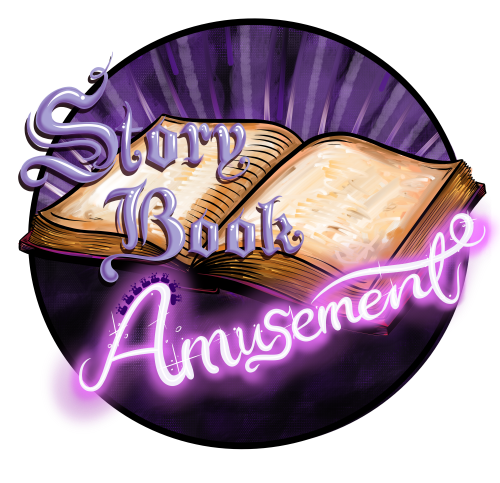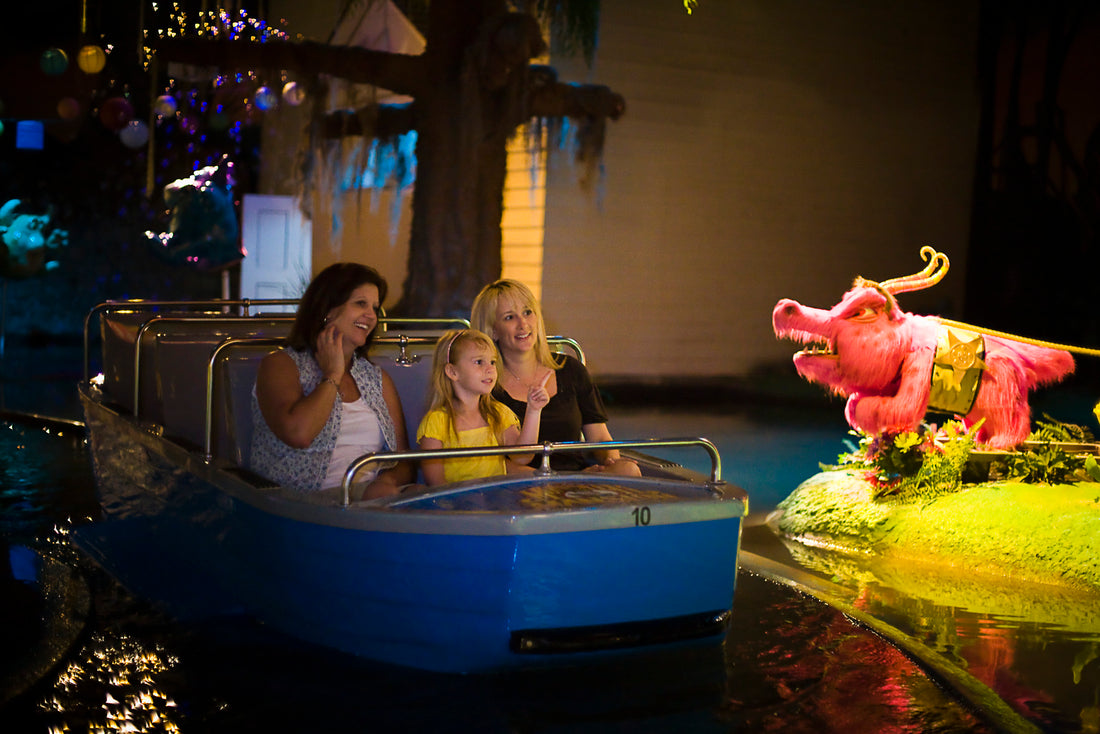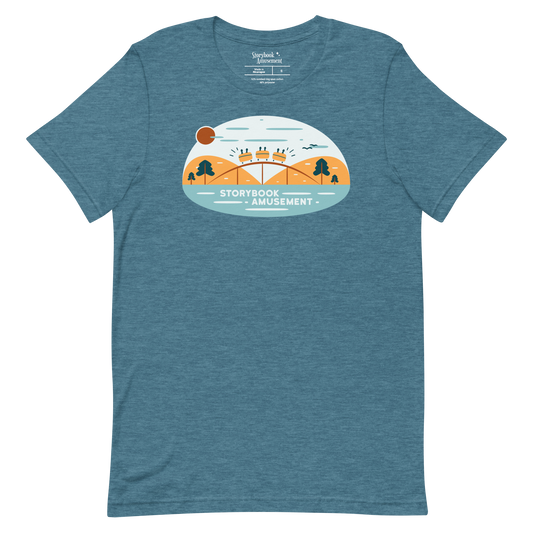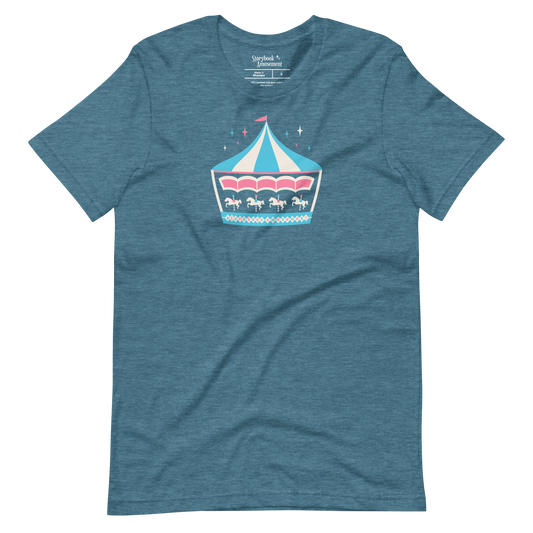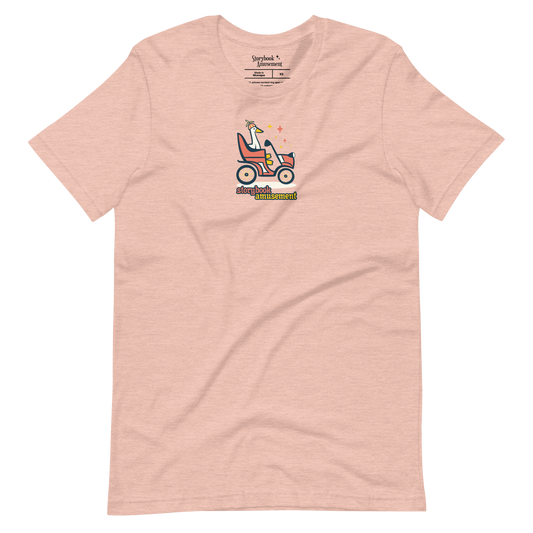This article is a continuation of the history of Tales of the Okefenokee. READ PART I
Reimagining the Swamp
Shortly after Six Flags Over Georgia closed for the 1980 season, work began on the new ride. Crews demolished many of the set pieces in the Tales of the Okefenokee show building. Essentially, all that remained after demolition were the building, the ride track itself, and very few props as well as murals. It has been rumored that the animatronics were destroyed during this process, but it’s currently believed some of the characters were saved by team members before demolition began.
Either way, Tales of the Okefenokee was officially gone, and Six Flags had intentions of creating a new fan-favorite ride that would be just as entertaining for adults as it would be for kids.
Former Disney Imagineer Dave Gengenbach was serving as Six Flags’ production supervisor at the time. According to Gengenbach, he made a “nasty crack” once about some rides in the chain. So, with a replacement for Tales of the Okefenokee on the way, leadership challenged him to head the development efforts of the company’s upcoming attraction in Georgia. Gengenbach accepted, saying that he had “one last good show” in him.
The project at hand would be a challenge as the new ride would have to be retrofitted into the existing ride layout and show building. Nevertheless, Gengenbach was determined to make it special.
“I know a lot of people liked the Okefenokee, and if they liked the Okefenokee, we’re going to blow their socks off.”
Dave Gengenbach
Watch on YouTube
This article is available in video form with added visuals. Click HERE to watch it.
The Disney Touch
Gengenbach, using his connections from Disney, recruited the most talented professionals in the industry for the project. The up-and-coming Gary Goddard Productions team was brought on to create the concept, story, characters, art direction, music production, and set design.
Gary Goddard’s team was experienced and innovative, including legends such as “Big Al” Bertino, of Country Bear Jamboree fame, and a phenomenal artist in Phil Mendez, among many others.
The team of creatives was in charge of coming up with the concept for the ride. They were looking to have a Southern theme to retain the local connection. An early idea wasn’t too far from the defunct Tales of the Okefenokee: a concept of hillbillies and singing rabbits.
While brainstorming, the team eventually landed on the idea of a sunken plantation, but that wasn’t enough.
Building on that idea, “Big Al” Bertino was inspired when playing with his granddaughter one day when she was pretending to be a monster. That moment sparked the concept for the upcoming ride.
Monster Plantation is Born
Introducing Six Flags’ soon-to-come attraction: Monster Plantation, featuring friendly creatures as well as frightening beasts. As the ride’s backstory went, the plantation was built in 1852 by Col. Beauregard “Mad Dog” Powell. After his death, the property was willed to his wife’s second cousin, who was on the monster side of the family. She opened up the plantation’s doors to the monster community, and it’s been a beastly bash ever since.
Years ago, the property was swamped in a great flash flood that has left the home submerged to this day. Fast-forward to 1981, a great-granddaughter, Mizzy Scarlett, now maintained the home and was a hospitable host for the countless humans visiting the former plantation where they were invited for a merry monster picnic.
With a $3 million price tag, the upcoming attraction was the most expensive in the park’s history up until that point. Given the scope of the work they were putting in, that high price point was clear in the results. They were making a quality attraction—a more-than-worthy replacement to such a beloved ride.
While Tales of the Okefenokee had a mostly playful tone, Monster Plantation would focus more on individual gags and over-the-top character design.
Monster Plantation would feature a massive cast of completely original characters. Illustrator Phil Mendez, who worked with Disney and Hanna-Barbera, made somewhere around 500 sketches of different monsters. About where he got the inspiration, Mendez said, “I created them based on people I know. Monsters are everywhere.”
With hundreds of character designs, some of the concepts were based on not only people Mendez knew, but also local public figures.
For example, his very own kids made it in as four sharp-toothed monsters reaching for a bee hive. A hostess named Mizzy Scarlett was meant to resemble Scarlett O’Hara from Gone with the Wind, a story that took place in and around Atlanta. A gargantuan monster in the marsh was called the Gengenbacher, named after the production supervisor, Dave Gengenbach. An easy-going monster named Buzby was created in honor of Georgia’s governor at the time, George Busbee. And, about the barbaric boat-eating monster aptly named the Boateater—well, Phil Mendez said, “That’s my mother-in-law.”
A Catchy Soundtrack
Much like the former Tales of the Okefenokee, Monster Plantation would have its own original soundtrack. Once the characters and storyboard were established, the team called composer Dick Hamilton to produce the ride’s music.
Hamilton wrote the lyrics as his daughters, son, niece, and wife sang them on the final track. Hamilton even added in some monster gibberish and other additional vocal parts. The infectious arrangement, featuring jazz instruments and synthesizer parts, laid down the foundation of the ride’s tone with its upbeat style.
The catchy melody and the music as a whole would play a major role throughout the attraction. The standout soundtrack changed styles as the ride progressed; it developed deeper into the ride to follow the story, characters, and setting.
“Once you get into the [marsh]...I was basically scoring a horror film. It’s real good to set up a contrast like that.”
Customized Animatronics
The music fit perfectly into the recipe the ride’s creators were cooking up. As the details were being finalized, Phil Mendez’s hundreds upon hundreds of character designs were eventually whittled down to about 130 outlandish characters that would take over the new attraction. That meant well over 100 monster animatronics had to be designed, developed, and programmed for the ride.
Monster Plantation would be a massive technical upgrade over the simple animated figures in Tales of the Okefenokee. Actually, it was going to be the first audio-animatronic dark ride of its kind outside of a Disney park—especially a ride of this magnitude. It would require highly qualified specialists to take on the animatronic demands of the audacious attraction.
Headed by a former Disney engineer, Alvaro Villa, the innovative AVG Productions team was hired to sculpt, fabricate, and engineer the mechanical figures. The animatronics were individually programmed for completely customized results.
“Everything we do is custom-made. Anytime you see a joint moving, it was custom designed for that figure. We don’t have any standard hardware because all of the characters are different in size and movements. That was most difficult in that we were really working on more than 100 different projects at once.”
Alvaro Villa
AVG worked closely with Goddard’s creative team, and they were able to fabricate remarkable animatronics with radiating personalities. Many were impressive in scale too, with some reaching up to 11 feet high and others 15 feet wide. Illustrator Phil Mendez complimented the engineers’ work, humbly saying the animatronics looked better than his sketches.
About the ride’s frenzied and unhinged atmosphere, Mendez commented, “One day, I was sitting inside the ride just looking around, and I realized it’s full of all these things I’ve always seen...it’s like sitting inside my head.”
Synchronizing the Music to the Visuals
That suspension of disbelief was extended to the sound design as well and how it correlated to the visuals. The music for the animatronic bands was mixed specifically to give a directional effect where the individual sounds seemed like they came directly from each instrument riders would see. Also, the movements of the animatronic musicians were synchronized to accurately match the soundtrack’s rhythms. These visuals were fined-tuned by the composer himself, Dick Hamilton, using a process he developed. This was for the most authentic results that made it seem as if the monsters were actually the ones playing the music.
“We did a lot of stuff that was very collaborative because Alvaro [Villa] was that kind of guy. He would come up with ideas, and he surrounded himself with people who were geniuses at what they did.”
Dick Hamilton, Nov. 22, 2022
The Final Details
With the storyline and technical details in place, it was time to transform the old Okefenokee into the brand-new Monster Plantation.
Production professionals from G&K Design worked on the ride’s lighting and sound systems. Since the expansive sets were installed in such a small space, presentation was crucial as the lighting team took the approach that each scene was essentially its own theater stage. The ride was truly coming to life.
The facade was transformed into a Southern plantation as the interior was being prepared. Over 100 artists and technicians converted the ride in an unbelievably tight nine-month time frame, getting it ready just in time for the park’s opening day in March 1981.
A Monstrous Opening
Once Six Flags Over Georgia opened for the 1981 season, guests could visit the twee and terrifying tenants over at the newly opened Monster Plantation. The boat ride, which followed the same ride path as Tales of the Okefenokee, accommodated 1,600 riders per hour with its 27 new boats, which held six passengers each.
Riders would board in front of the grand plantation facade and into an opening to the left of its front door. Inside, the home’s elegant interior, complete with chandeliers and tasteful furniture, had seen better days as pictures hung crookedly and decorations were in disarray—not to mention the gushing river flowing through the house. But that wouldn’t matter to the enthusiastic Mizzy Scarlett, who warmly greeted each guest. The lively and neighborly environment set the tone while the upbeat theme played.
From there, the boat approached a set of double doors that swung open to the grounds of the plantation. Music spilled out of the opening doors as the boat floated toward the first welcoming monsters outside: a jazz band known as the Lagoon Goons. They played the main theme in their peppy style while dream-like lighting coated the erratic scenery. Around the set, an overwhelming array of fuzzy monsters enjoyed their picnic and radiated their positive mood to the riders.
The ride was way too detailed to point out every character or quip, but here are some of the highlights. While the rhythmic melody played, riders floated toward one of the monsters who would make multiple appearances in the ride: Marshall Billy Bob Fritter. He welcomed the riders but sternly warned them very early on to stay out of the marsh.
Families of monsters enjoyed themselves along the banks of the floodwaters, with no two characters looking alike. Hijinks and smiles were had by monsters of all ages along the stream. Some were swinging and soaring while others played pranks on one another and others climbed atop each other to ruffle a beehive. A group of monstrous birds blurted off to the side as the boat neared the next room.
Around the corner was a tree-covered area filled with joyous monsters, once again, but now were enjoying a few carnival-like activities during the monster picnic. The riders saw a smooching monster in a kissing booth, but likely with failed luck as the price was reduced from “cheap” to “free.” The other monsters instead were busy playing horseshoes, bobbing for apples, sampling a chili cook-off, competing in a pie eating contest, or taking part in a number of carnival games.
A country band strummed the droning melody as heard throughout the ride—this time, with a folksy twang. A group of cheerleaders celebrated on the side with two monsters showing off their motorcycle nearby. The scene ended with a clumsy tennis player eager to find someone to join and a long-haired monster showing off his “monster power” T-shirt.
From here, the tone shifted, just like how Tales of the Okefenokee took a dark turn. Up ahead, two tipsy monsters found themselves yapping in a dark graveyard—while they were carefree, riders had something to be concerned about. The way back to the plantation was up ahead, but the boat was turning too far to the left. In a panic, Marshall Billy Bob Fritter returned as he stood on top of his car. As the boat missed its turn, Billy Bob Fritter warned riders of the dangers up ahead in the dreaded marsh, where humans were forbidden.
With no turning back, the boat rumbled up a small lift hill, made its way under “keep out” signs, and plunged into the unknown darkness of the marsh. Sounds of bellowing beasts boomed from every which direction as the boat ventured deeper into the shadows. Giant spiderwebs glowed as a foreboding primer of the horrors ahead.
An ogre emerged from the blackness, shouting and pointing at the riders, “Humans!” Ghastly creatures guarded their hoard of treasure, staring sinisterly with glowing eyes. Monsters from all angles growled and made it known the humans weren’t allowed in the marsh. With sharp teeth, fierce eyes, pointed snouts, and vengeful spirits, the swarm of savages lurked all around the marsh, which was draped in piercing darkness that otherwise existed only in nightmares.
The marsh came to a bright opening where Marshall Billy Bob Fritter was waiting for the boat as he ushered riders back to the plantation. The Lagoon Goons were heard once again, playing their jazzy version of the theme song. Some monster friends were relaxing by the fishing pond with a warmhearted “g’bye” while the boat returned to the plantation.
A tunnel leading to the outside world gave riders one last scare, with the ambiance of a drippy cave that fed straight into a humongous boat-eating monstrous mouth. Passing under the knifelike teeth, the boat made it out safely to the exterior of the plantation, returning to the lyrical theme song that played on a loop. Guests exited their boat and stepped back onto dry land to check out the rest of Six Flags Over Georgia.
A New Fan Favorite
Monster Plantation quickly proved to be a great addition to the park. It was popular in obvious ways: being nicely air-conditioned on hot summer days and being a place where teenagers could get away for a few minutes.
Monster Plantation spawned a mini monster mania with some postcards, coloring books, and even costumed walkaround characters. The monsters were instantly lovable and memorable.
The dedication and work behind creating this ride made it a success. The creative team’s achievements in such a short turnaround resulted in a fan-favorite attraction for many years to come. It was professionally executed, with every detail nicely presented—all the way down to the lighting and sound design.
The ride was set up in a similar way to Tales of the Okefenokee, with animatronics putting on a show among scenery and murals. Tales of the Okefenokee, however, tried to tell mini-stories within a rather small venue. The creators of Monster Plantation made use of wide-open sets and a massive lineup of characters whose one-off gags and energy collectively built an entire scene. These large areas were sectioned off to contain the shifting mood in the ride, but the symphony of jumbled pandemonium unified the essence of what made Monster Plantation a standout attraction.
The murky waters and wacky monsters created a lovable experience that generations of Atlantans would connect with. Monster Plantation would be a staple in the park through the ‘80s, the ‘90s, and into the 2000s.
Bright Moments & Black Eyes
Unfortunately, though beloved, the ride still had its issues. For starters, Monster Plantation was located in the aforementioned Confederate section of the park. There were even references to the Confederate States of America located in the ride during its most heroic moment. It goes without saying that this topic was not worth celebrating, especially in a theme park where families of all backgrounds came to make memories.
And of course, the name of the ride itself was problematic: Monster Plantation. Sure, it was a different time when the ride was developed and built, but as decades passed, change eventually was needed.
Rumblings & Rumors
The characters from Looney Tunes were at one point rumored to take over the building, similar to how Speelunker’s Cave in Texas became Yosemite Sam's Gold River Adventure in the early ‘90s. Keep in mind, Speelunker’s Cave was a heavy influence for Six Flags Over Georgia to have an animatronic boat ride in the first place.
In the early 2000s, a similar boat ride at Six Flags St. Louis had been rethemed to a ride called Scooby-Doo! Ghostblasters: The Mystery of the Scary Swamp. It was realistic to believe the interactive boat ride could’ve made its way to Georgia as well, replacing Monster Plantation. It was rumored that the Mystery Gang was destined for Atlanta’s classic boat ride.
Six Flags had been evaluating Monster Plantation into the 2000s, more than 20 years after it debuted. The monsters had been ingrained in local culture, but the park and associated creative firms had discussed the possibility of bulldozing the attraction in favor of something new.
Six Flags Over Georgia had changed significantly since Monster Plantation’s opening. Intense coasters had been scattered around the park, and Six Flags as a whole seemed to be distancing itself from highly themed rides. Monster Plantation, with its cast of completely original characters, was not safe under the direction of Six Flags at the time given their alternatives with more recognizable properties like Looney Tunes or Scooby-Doo. Not to mention, Monster Plantation was a slow-moving ride—among hair-raising roller coasters themed to superheroes, the building’s location could have possibly been used for a more thrilling ride that better fit the overall temper of the park.
The Ride's Waning Condition
Much like how Tales of the Okefenokee was in its final years, Monster Plantation into the new millennium was in need of a major refurbishment, at the very least. The overall condition of the animatronics and sets was embarrassing. A visible, thick layer of dust covered the entire attraction, and the animatronics were known for not operating properly—and in unsettling ways. Combining this with the ride’s unfortunate themes, Six Flags needed to make an action.
Six Flags recognized Monster Plantation’s glaring issues and took the opportunity not only to modernize the theme of the ride, but also completely renovate the longstanding attraction as a whole and make it more enjoyable for years to come. The update would retain the ride’s unique blend of gags and Southern charm while wisely removing ill-advised references.
The Future of the Plantation Mansion
It was official: Monster Plantation was set to close at the end of the park’s 2008 operating season. The attraction as it was known for 27 years would be retired. Monster Plantation lasted twice as long as its predecessor, Tales of the Okefenokee—so long that the monsters had become local icons. Six Flags knew what this ride meant to the park’s visitors, so they decided to remodel it.
“The ride became a rite of passage for youth growing up in the area. Because it’s become so iconic, we really wanted to renovate and upgrade the existing ride, keeping the popular storyline intact. Now, individuals who experienced Monster Plantation as young children can ride Monster Mansion with their own kids.”
Melinda Ashcraft, Former Six Flags Park President
Ashcraft was a young employee when the attraction originally opened in 1981, so her personal connection to the ride developed into a supportive approach to renovate, not replace.
Thus, Six Flags made the decision not only to revamp the historic attraction, but also bring back the creators who made Monster Plantation in the first place: Gary Goddard Entertainment.
Some of the original team, like animator Phil Mendez, returned to overhaul Monster Plantation—not only freshening up the experience, but also reimagining the troubled concepts used in the original.
“This [ride] is part of Atlanta,” said Gary Goddard, commenting on what the attraction has meant to longtime Six Flags visitors. With the chance to creatively revisit this attraction, the Goddard Entertainment team assessed Monster Plantation as a whole, seeking opportunities to update the ride while maintaining its well-known charm.
New blue sky concepts that kept the monster theme were considered—like an open house or a family reunion. Ultimately, the monster picnic plot would return in an all-new way that felt familiar. The updated attraction would simply be named Monster Mansion.
With that, the plantation was ready to be transformed into a mansion.
The ride would once again use the existing ride system that had been reliably in operation since the ‘60s. Major improvements were made to the animatronics and the ride as a whole. Nearly 100 animatronics were completely refurbished down to their bones with upgraded fabrications and pristine coats of fuzzy fur. In fact, it took 250 yards of new fur to outfit the hordes of monsters. And, the mansion got even more crowded; eight new animatronics of new characters moved into the mansion as well, joining the familiar cast of offbeat creatures.
Inside the 25,000-square-foot building, the sets were stripped and completely renovated, from the murals to the colorful shores. To some extent, Monster Mansion was being treated like a completely new ride. The refurbishment was extensive—beyond updating a few problematic references.
The mansion was also being upgraded with new effects to bring the ride into the 21st century. This included lighting, water effects, and the sound system, just to mention a few.
Speaking of the audio, Dick Hamilton, the composer of the original soundtrack, provided a copy of the master audio tracks to give the updated attraction the same brand-new sheen it had nearly three decades prior.
Monster Mansion would soon have an opening-day polish as construction wrapped up. About 300 people worked on the ride over the park’s off-season to prep the mansion for its opening day.
A Grand Reopening
In May 2009, Monster Mansion made its debut as a choir of elementary school students with puppets sang the ride’s classic theme song. Guests were once again invited in—this time to a mansion.
The water once again flowed through the flooded grounds of the mansion, and the assemblage of animatronics, given new life, once again put smiles on guests’ faces. The mansion impressed, once again washed with color, drowned with music, and overflowed with delight.
Six Flags capitalized on the revitalization of the monsters, adding the MonStore retail shop with merchandise of the ride’s well-liked characters. The MonStore also had a small museum-like tribute that recognized the attraction’s history. Looking ahead, it was great to have a revived Monster Mansion in the park.
For the everyday theme park guest, Monster Mansion provided what the ride had been decades: a silly way to get out of the heat, get off your feet, and enjoy a five-minute-or-so serenade of nonsense. For the die-hard fans, it was the return of a classic with an impressive collection of animatronics and satisfying dark ride goodness that was worth riding over and over.
Those enthusiasts may have been the only ones to notice the changes in the attraction. While it got an overall refresh, the additions were mostly subtle as the ride maintained its legacy of being a one-of-a-kind experience. Among the more obvious changes included a new animatronic, appropriately named Papa Razzi, at the beginning of the ride to take riders’ pictures. Other noticeable additions included water-spouting frogs along the flood waters and a cluster of menacing eyes wickedly glaring at riders as they entered the forbidden marsh.
However, with a new era of monsters taking over the mansion, the past was not forgotten; a portrait of a few characters from Tales of the Okefenokee hangs on the wall inside the first scene in the mansion, and nods to former Six Flags leaders are etched into the tombstones in the graveyard by the marsh. One of the monsters was slightly remodeled to take after Big Al Bertino, clumsily spraying water from his gardening hose. These tributes serve as a reminder that an attraction like Monster Mansion can transcend generations, but it wouldn’t have been possible without a dedicated group of creatives.
The ride itself has evolved over the years, but it’s the same waterway where children half a century ago made memories. Tales of the Okefenokee, even though scarcely documented, is a well-remembered dark ride that fans young and old still love to think back on—fans have even recreated it online to blissfully get a hint of what being on the long-defunct ride would have been like. Not to mention, Disney’s notorious log flume, Splash Mountain, has obvious connections to the old Okefenokee ride, but that’s a story in and of itself.
As for Monster Mansion, the ride is alive and well for now. It’s among one of the longest operating rides at Six Flags Over Georgia as multiple generations have grown to love the monster picnic shenanigans and the nightmares found in the marsh. Its impact has inspired fan art and proves to be a favorite among Six Flags guests—an unrivaled dark ride locals can call their own. Monster Mansion hasn’t been cloned across the Six Flags chain; it’s the very definition of a one-of-a-kind ride that is perfectly wedged into the Thrill Capital of the South. Enjoying a ride on Monster Mansion during your visit to Six Flags Over Georgia is just as essential as your admission to the park itself.
There’s comfort in knowing this somewhat hidden gem has stood the test of time alongside Six Flags’ extreme roller coasters people come through the turnstiles for. Monster Mansion is here waiting for you. As always, you’re invited to a picnic. But for now—bye, y’all.
